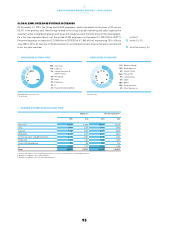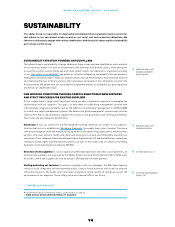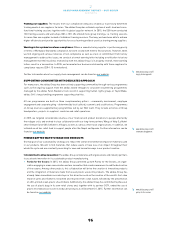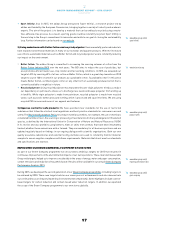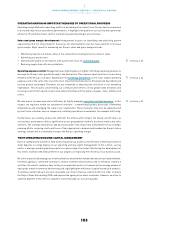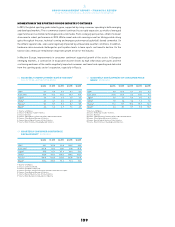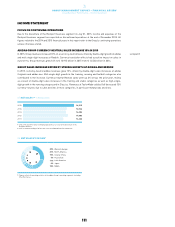Reebok 2015 Annual Report Download - page 107
Download and view the complete annual report
Please find page 107 of the 2015 Reebok annual report below. You can navigate through the pages in the report by either clicking on the pages listed below, or by using the keyword search tool below to find specific information within the annual report.
GROUP MANAGEMENT REPORT – FINANCIAL REVIEW
Internal Group Management System
103
3
OPERATING MARGIN AS IMPORTANT MEASURE OF OPERATIONAL PROGRESS
Operating margin (defined as operating profit as a percentage of net sales) is our Group’s key focus measure
to drive and improve our operational performance. It highlights the quality of our top line and operational
efficiency. The primary drivers central to enhancing operating margin are as follows:
Sales and gross margin development: Management focuses on identifying and exploiting growth
opportunities that not only provide for future top-line improvements, but also have potential to increase
gross margin. Major levers for enhancing our Group’s sales and gross margin include:
•Minimising clearance activities, while at the same time increasing full-price share of sales.
•Optimising our product mix.
•Improving the quality of distribution, with a particular focus on controlled space.
•Realising supply chain efficiency initiatives.
Operating expense control: Management puts high emphasis on tightly controlling operating expenses to
leverage the Group’s sales growth through to the bottom line. This requires a particular focus on ensuring
flexibility in the Group’s cost base. Expenditure for marketing investments is one of our largest operating
expenses and at the same time one of the most important mechanisms for driving brand desirability and
top-line growth sustainably. Therefore, we are committed to improving the utilisation of our marketing
expenditure. This includes concentrating our communication efforts on key global brand initiatives and
focusing our promotion spend on well-selected partnerships with top events, leagues, clubs, athletes and
artists.
We also aim to increase operational efficiency by tightly managing operating overhead expenses. In this
respect, we regularly review our operational structure – streamlining business processes, eliminating
redundancies and leveraging the scale of our organisation. These measures may also be supplemented
by short-term initiatives such as temporarily curtailing operational investments, for example staff hiring.
Furthermore, we carefully analyse the different mix effects which impact the Group’s profit ratios, as
our business performance differs significantly across geographical markets, business models and sales
channels. The strategic implications and decisions taken in this respect are a key element of our strategic
planning efforts, ensuring clarity and focus of the organisation to balance and broaden the Group’s future
earnings stream and to sustainably increase the Group’s operating margin.
TIGHTOPERATINGWORKING CAPITAL MANAGEMENT
Due to a comparatively low level of fixed assets required in our business, the efficiency of the Group’s balance
sheet depends to a large degree on our operating working capital management. In this context, our key
metric is average operating working capital as a percentage of net sales. Monitoring the development of
this metric facilitates the measurement of our progress in improving the efficiency of our business cycle.
We strive to proactively manage our inventory levels to meet market demand and ensure fast replenishment.
Inventory ageing is controlled carefully to reduce inventory obsolescence and to minimise clearance
activities. As a result, inventory days lasting is an important metric as it measures the average number of
days goods remain in inventory before being sold, highlighting the efficiency of capital locked up in products.
To optimise capital tied up in accounts receivable, we strive to improve collection efforts in order to reduce
the Days of Sales Outstanding (DSO) and improve the ageing of accounts receivable. Likewise, we strive to
optimise payment terms with our suppliers to best manage our accounts payable.
see Glossary, p. 260
see Glossary, p. 260
see Glossary, p. 260


